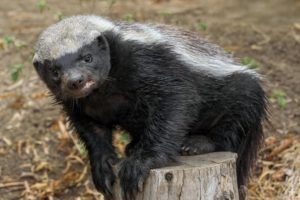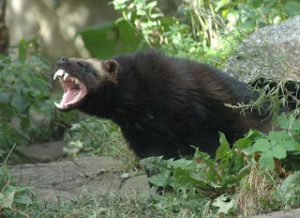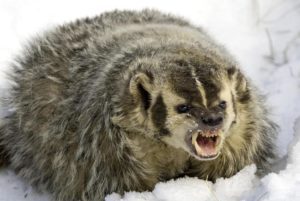Podcast: Play in new window | Download (Duration: 15:37 — 15.6MB)
It’s badger week at Strange Animals Podcast, thanks to a suggestion by Richard E.! I knew the honey badger was something special, but I had no idea how special. And by “special” I mean “terrifying.”
Shout-out to Turn of Phrases podcast just because I love it so much. It’s a short, family friendly podcast that explains the weird idioms we say without thinking about them.
A honey badger. Look at that adorable snarl!

A wolverine and its TEETH:

An American badger:

A European badger:

Show transcript:
Welcome to Strange Animals Podcast. I’m your host, Kate Shaw.
I’ve been getting a bunch of great topic suggestions and I’m falling behind on addressing them, so this week I was going to cover two or three suggestions in one big episode. I started with the honey badger, though, and soon I realized this animal and some of its close relations deserved an episode to themselves.
The honey badger was suggested by Richard, who has also sent lots of other great topic suggestions I’m working on. That’s not my brother Richard, it’s a different Richard. Hello to both of you.
The honey badger sounds like it should be a cuddly Pooh-bear kind of animal that gets its hand stuck in the honey jar and its friends have to help free it. In fact, the honey badger is a terrifyingly dangerous animal that’s related to other badgers, as well as to weasels, wolverines, and otters, although not closely. One interesting thing I just found out: the European badger is not all that closely related to the American badger. In fact, the American and European badgers are about as closely related to each other as they are to the honey badger. The European badger is more closely related to the wolverine than it is the American badger and the honey badger. We’ll look at all these animals this week.
The honey badger has short legs, a broad body, a flattish head with a stubby nose, small ears and eyes, a medium-length tail, and strong claws. That’s the same rough description of the wolverine and the European and American badgers too. Its fur is black with a broad pale gray or white stripe from the head down the back, although one subspecies of honey badger is all black. The honey badger lives in Africa, India, and Southwest Asia, and while it only stands around a foot high at the shoulder, or 28 cm, its ferocity means it basically has no predators. Its skin is so thick and tough that arrows, spears, and even machetes don’t do much damage. Even small-caliber bullets can’t fully penetrate its skin. Setting a pack of dogs on a honey badger just ends up with a lot of unhappy, or possibly dead, dogs, because in addition to being ridiculously thick, the honey badger’s skin is extremely loose. If an animal bites it, the honey badger can still twist around and attack with its massive front claws and teeth. Not only that, but the honey badger has more stamina than its attacker, guaranteed, and it will continue to fight tirelessly forever.
The honey badger eats meat, some plant material like berries and roots, and pretty much anything else it can get. Most of the animals a honey badger hunts are small, rodents and frogs and things like that. It can even bite through tortoise shells with its powerful jaws, and will kill and eat even the most venomous snakes since if it does get bitten, like the mongoose, it is naturally resistant to venom. It eats all of whatever it kills, even fur, bones, and feathers. Occasionally a honey badger will chase another animal away from its kill, including lions. Yeah, even lions don’t want to mess with the honey badger—although lions do sometimes kill honey badgers, usually when a honey badger attacks it.
The honey badger gets its name not from its sweet personality, because it’s actually an ornery animal that will attack anything that comes near its burrow, but because it raids beehives—not for its honey, but for bee larvae. Like bears, which can raid beehives without worrying too much about getting stung through its thick fur, the honey badger doesn’t usually have much problem with bee stings. But sometimes there are too many bees even for the honey badger, in which case it has a secret anti-bee weapon.
The honey badger has an anal pouch that holds secretions that are really, really stinky. Skunk stinky. It can turn the pouch inside out to release the stink, which may stun or calm the bees the way a beekeeper calms bees with smoke.
As if all this isn’t fearsome enough, the honey badger is also intelligent and shows occasional tool use, like moving a log to stand on to reach prey. It also digs extremely well. And it’s not a slow animal at all. In fact, it can be kind of frenetic like its weasel cousins. And when it attacks animals larger than itself, like lions, it goes for the scrotum.
Baby cheetahs are born with broad white stripes down their backs, and some researchers think that coloring mimics the honey badger’s coloring and helps keep potential predators away.
The honey badger is called the ratel in South Africa, because of the sound it makes. I tried really hard to find audio of a honey badger that wasn’t overlaid with music or people talking, without luck. The closest I have is a honey badger attacking a cobra, but mostly what you hear is the cobra hissing. The cobra is not having a good day. You can hear the honey badger chatter a little, but it just sounds like a couple of squeaks. Here it is, for what it’s worth.
[honey badger and cobra sounds]
The wolverine is another animal in the Mustelidae family, and like its cousin the honey badger, it has a reputation for being ferocious. It also has a way better name than the honey badger, with an X-Men character, a bunch of sports teams, and a Swedish metal band named after it. On the other hand, it’s also sometimes called a skunk bear or nasty cat because of its anal scent glands, which it uses to mark its territory. It mostly lives in Alaska and northern Canada, Siberia, and parts of Norway, Sweden, and Finland.
The wolverine is short and broad like the honey badger and is about the same size, or a bit larger, but it looks much more like a tiny bear. It’s light brown with darker brown or black legs, muzzle, tail, and back. It eats a lot of carrion, but it will also kill animals, from squirrels and mice all the way up to moose and caribou. It will also eat some plant material, like seeds and berries. The wolverine has a thick hide like the honey badger, but it’s not quite in the honey badger’s league. Bears and wolves will sometimes kill wolverines.
The wolverine lives in cold climates. Females dig dens in the snow to have their babies in late winter and early spring. Its fur is thick and water-repellent, and in old-timey times its fur was prized and used to line parkas and other clothing. Shout-out to the Turn of Phrases podcast for putting old-timey times into my everyday vocabulary. The wolverine also has a single tooth in the back of the jaw that sticks sideways into the mouth and helps it tear off meat from frozen carcasses. A wolverine will cache carcasses at the beginning of winter, which gives it food when the snow is deep and there’s not much else to eat.
The wolverine was once much more widespread, but as the last ice age ended about 12,000 years ago its range became more northerly. It’s also been trapped and killed for its fur and to stop it from killing livestock. But male wolverines in particular can range widely, and occasionally one strays farther south. In 2016 a tagged wolverine was tracked as it traveled more than 800 miles, or almost 1300 km, through Wyoming, Colorado, and North Dakota, where it was killed by a ranch-hand.
In 1992 and 1994 a pair of wolverines were seen repeatedly in parts of Wales and England, and a dead one was reported on the side of the road, apparently killed by a car. Only about a hundred wolverines are kept in zoos, and a zoo would notice if a couple of its wolverines disappeared. Wolverines don’t make good pets, to say the least, so they probably weren’t escaped pets. The general consensus is that they must have been escapees from a fur farm—but wolverines don’t do well in captivity and rarely breed successfully even in zoos. So where they came from is a mystery, and unfortunately no one thought to retrieve the body or even take a photograph so it could be positively IDed.
Lastly, we’ll look at the relatively mild-mannered European badger and American badger. They look very similar, but as I noted at the beginning of the episode, they’re not all that closely related. The badger has a wide body that’s mostly gray with short legs that are darker gray or black. The tail is not stubby but not especially long. The face is black with white markings. The European badger has a broad white stripe that runs from the tip of its nose to between its ears, and a white stripe on both cheeks. The American badger has a thin white stripe that starts farther back on the nose and runs over the top of the head and down the neck, and black and white striped cheeks. Both are strong diggers that live in burrows.
The American badger is found throughout western and central North America, from parts of Canada to northern Mexico. It eats a lot of mice, groundhogs, ground squirrels, prairie dogs, pocket gophers, and basically any little animal it can dig up from its burrows. It also eats lots of snakes, including rattlesnakes. Like its cousin the honey badger it likes to eat bee larvae and honey, and it will eat some plant material too. It also will eat skunks. Not many things want to eat skunks.
Occasionally a badger will team up with a coyote to hunt. That’s not scary at all. Badgers are aggressive, but certainly nowhere near as ferocious as a honey badger or even a wolverine. It’s a bit smaller than the honey badger and wolverine.
In 2017, a research team studying scavenging behaviors of various animals inadvertently learned a lot about the badger. The team had staked out calf carcasses and set up camera traps to document which animals came to eat the carcasses. One of the cameras recorded a badger burying a calf carcass deep enough that it would be safe from other scavengers and would remain cool underground for the badger to eat it later. It took the badger five days and a lot of work, but since the calf was considerably larger and heavier than the badger, it would have a lot of meat to snack on later in the winter. Another of the cameras caught a different badger attempting to bury another calf carcass, but that badger wasn’t successful. Researchers suspect this caching activity may be common among badgers, but no one knew about it because badgers are mostly nocturnal. While ranchers typically dislike badgers, burying large carcasses is beneficial to ranchers since it minimizes the spread of disease to cattle and other livestock.
The European badger is much more social than its American cousin, which is mostly solitary. It lives in groups in complex burrows called setts. A badger doesn’t just poop wherever it happens to be, it uses a latrine, and it may have more than one latrine in its territory just as it may have more than one sett. It also likes to change out the bedding material in its burrows, taking old bedding out and bringing in clean, fresh bedding. In winter, when good bedding material isn’t available, it may take its old bedding out on sunny days to air, then retrieve it later. It’s like this animal was invented to star in children’s storybooks. If you told me badgers routinely wear little flowered aprons and use tiny brooms to sweep their burrows, I wouldn’t bat an eye. Sometimes a red fox will live in part of a badger’s burrow, and I picture the fox wearing a neat tweed suit. He probably pays rent to the badger family.
The badger hibernates during the worst part of the winter, although when winters are mild, it may only sleep for part of the winter or not at all.
The European badger does eat meat, but it also eats a lot of plant material, especially fruit and grains, but also clover and even grass if it has to. It mostly eats earthworms, but will also catch insects, small mammals like mice, hedgehogs, and young rabbits, snails and slugs, and tortoises. It also likes bee and wasp larvae and will eat wasp nests, ignoring the stings it receives. Sometimes a badger will kill a lamb or break into a chicken coop and kill lots of chickens, but that’s rare and usually only happens when other food is scarce.
Unfortunately, the badger has a bad reputation in Great Britain as a carrier of bovine tuberculosis. It does carry the disease, but recent studies show that it doesn’t appear to infect cattle. Cattle catch TB from other cattle, not from badgers. Culling badgers to stop the spread of TB among cattle doesn’t help either the cattle or the badgers, since after a badger cull, other badgers move into the dead badgers’ former territory, bringing TB with them. It’s very difficult to eradicate a disease from a wild animal population, but it is completely possible to eradicate a disease from domestic animals. In Wales and Scotland, cattle tuberculosis is on the decline due to frequent testing for the disease, while in England, where the primary treatment for TB is to go out and kill a bunch of badgers, it’s on the rise. So leave the badgers alone. Mrs. Badger is busy busy washing linens and hanging them to dry on tiny clotheslines while Mr. Badger is repairing the white picket fence where he grows his prize-winning dahlias, and the Badger children are helping Auntie Badger make scones for Mr. Fox’s tea.
You can find Strange Animals Podcast online at strangeanimalspodcast.com. We’re on Twitter at strangebeasties and have a facebook page at facebook.com/strangeanimalspodcast. If you have questions, comments, or suggestions for future episodes, email us at strangeanimalspodcast@gmail.com. If you like the podcast and want to help us out, leave us a rating and review on Apple Podcasts or whatever platform you listen on. We also have a Patreon if you’d like to support us that way.
Thanks for listening!